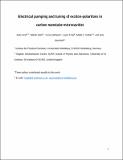Electrical pumping and tuning of exciton-polaritons in carbon nanotube microcavities
Abstract
Exciton-polaritons are hybrid light–matter particles that form upon strong coupling of an excitonic transition to a cavity mode. As bosons, polaritons can form condensates with coherent laser-like emission. For organic materials, optically pumped condensation was achieved at room temperature but electrically pumped condensation remains elusive due to insufficient polariton densities. Here we combine the outstanding optical and electronic properties of purified, solution-processed semiconducting (6,5) single-walled carbon nanotubes (SWCNTs) in a microcavity-integrated light-emitting field-effect transistor to realize efficient electrical pumping of exciton-polaritons at room temperature with high current densities (>10 kA cm−2) and tunability in the near-infrared (1,060 nm to 1,530 nm). We demonstrate thermalization of SWCNT polaritons, exciton-polariton pumping rates ~104 times higher than in current organic polariton devices, direct control over the coupling strength (Rabi splitting) via the applied gate voltage, and a tenfold enhancement of polaritonic over excitonic emission. This powerful material–device combination paves the way to carbon-based polariton emitters and possibly lasers.
Citation
Graf , A , Held , M , Zakharko , Y , Tropf , L C , Gather , M C & Zaumseil , J 2017 , ' Electrical pumping and tuning of exciton-polaritons in carbon nanotube microcavities ' , Nature Materials , vol. 16 , pp. 911-917 . https://doi.org/10.1038/nmat4940
Publication
Nature Materials
Status
Peer reviewed
ISSN
1476-1122Type
Journal article
Description
This research was financially supported by the European Research Council under the European Union's Seventh Framework Programme (FP/2007-2013)/ERC Grant Agreement No. 306298 (EN-LUMINATE) and under the European Union’s Horizon 2020 Framework Programme (FP/2014-2020)/ERC Grant Agreement No. 640012 (ABLASE) and by the Scottish Funding Council (through SUPA). L.T. thanks the EPSRC for support through the CM-DTC (EP/L015110/1). J.Z. thanks the Alfried Krupp von Bohlen und Halbach-Stiftung via the “Alfried Krupp Förderpreis für junge Hochschullehrer” for general support.Collections
Items in the St Andrews Research Repository are protected by copyright, with all rights reserved, unless otherwise indicated.

